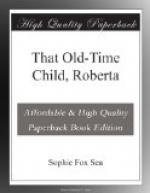Yes, she would go to Mam’ Sarah at the loom-house. It was considered a great treat by Roberta to go down to the loom-house. That was where the wool, cotton, and flax was carded, spun, and wove, then manufactured into winter and summer clothes for the negroes on the place. Yard upon yard of beautiful red and black flannel, blue and brown linseys, and blue and white striped cottonades, for the women, jeans for the men, and that coarse fabric called tow-linen made from the refuse of flax. The wonderful counterpanes, I have mentioned before, were manufactured there and the linen for sheets and towels. Let me tell you something curious while I am on the subject of the loom-house: Roberta’s grandmother raised silk-worms in the room adjoining. She fed them on mulberry leaves. Mam’ Sarah told Roberta they made a noise like wind while they were feeding. Those worms spun fluffy balls of silk, called cocoons, that the old lady reeled her silk thread from. She had all the silk thread and embroidery floss she needed.
There were no silk-worms raised in Roberta’s time, and the room was given up to other uses.
There was kept the huge iron mortar where the grains of corn were crushed to make the delicious hominy Kentuckians are so fond of. When rightly prepared each grain stands out like the beautiful white-plumed corn captains and colonels that dance up so gaily over beds of live coals. There were made also the tallow dips, almost the only light used in the old days on the farms in Kentucky. Pieces of cotton wick were cut the required length and fastened at regular intervals to sticks of wood. One of the rows of wicks was dipped in the melted tallow, taken out and suspended over a vessel to drip. Then another was dipped, and another, till the same process was gone through with all. That was repeated many times before the wicks held enough tallow to be used for candles. An improved method was to run the wicks through tin molds, the required size and shape, and fasten them at one end with a knot; then pour in the melted tallow, and set the molds aside for the tallow to harden. The candles were put in brass, silver, and bronze candlesticks, accompanied by quaint little waiters that held snuffers, used to nip off the charred wick, as the tallow melted away from it. Very primitive that, compared with the brilliant luminaries we have now.
Well, there were hanks of different colored yarns and strings of red peppers hanging from the ceiling of the loom-house. Great beams ran through, called “warping bars,” where the various warp threads were measured and cut for the loom. There were scutchens for dressing flax, carding combs, spinning wheels, and the great wooden loom with shafts reaching almost to the ceiling.
It was prime fun for Roberta to go down to the loom-house in the long winter evenings, and, sitting down before the open fire-place, help Polly and the others card the wool in long, smooth “curls,” and pile them in even layers, ready for the spinner.




